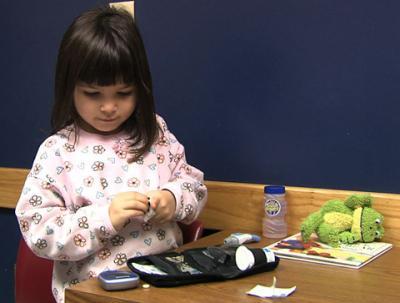We recognize that diabetes is a "serious disease", but how serious is it? Kentucky ranks 9th in the nation for diagnosed diabetes! One in seven Kentuckians or more than 300,000 individuals has diabetes and that doesn't include individuals under the age of 20! Nationally less than 1% of this age group has diabetes which suggests that approximately 3,000 children and youth in Kentucky may have the disease and the number continues to climb! This month on "Its About You", Patti Geil, Lexington- based Registered Dietitian and a nationally recognized diabetes educator along with Melissa Combs-Wright, RD, and Diabetes Educator at the University of Kentucky Department of Pediatric Endocrinology provide insights on diabetes management for children and the entire family.

Core Messages:
- Diabetes is a disease that affects the whole family, especially when a child is diagnosed.
- There are two types of diabetes. Type 1 diabetes is usually diagnosed in children and young adults, and was previously known as juvenile diabetes. In Type1 diabetes, the body does not produce insulin- a hormone that is needed to convert sugar (glucose), starches and other food into energy needed for daily life. Only 5-10% ofpeople with diabeteshave this form of the disease.
- Insulin therapy along with healthy eating will help children of all ages to manage their disease. Childrenwith type 1 diabetes can learn to manage their condition and live long, healthy, happy lives.
- Type 2 diabetes is the most common form of diabetes and previously known as adult onset. In type 2 diabetes, either the body does not produce enough insulin or the cells ignore it. Statistics show type 2 diabetes is becoming more common among youth. Today,fifty percent of newly diagnosed diabetes in children is type 2. This increase of type 2 diabetes in children is very concerning because it is a disease that can lead to potential lifelong complications and a shorter life expectancy than their parents.
- Overweight, sedentary lifestyle and family history are risk factors for the onset of type 2 diabetes. In Kentucky, the prevalence of overweight in children and adolescents has doubled and even tripled over the past five years.
- In type 2 diabetes, healthy eating and an active lifestyle are the key components in managing the disease. Oral medication may be required, but insulin therapy is not necessary if lifestyle changes are made.
- Healthy eating for the whole family is a good lifestyle change. Creating a healthy plate is the first step! The "plate method" is an easy way to increase the portions of non-starchy foods and decrease the starchy ones. To create a healthy plate, put a line down the middle of a dinner plate, then on one side, cut it again so you will have 3 sections on your plate. Fill the largest section with non-starchy vegetables (carrots, green beans, spinach), put starchy foods in one of the small sections (potatoes, pinto beans) and put meat or meat substitutes in the other section .Add an 8 oz glass of non-fat or low-fat milk and a piece of fruit or a 1/2 cup fruit salad and you have your meal planned.
- Children of all ages can learn to prepare quick and healthy snacks, using convenience foods such as string cheese, deli meats, whole wheat tortillas, and fruit.
- Regardless of the type of diabetes a child has, leading a physically active live is an important component in managing the disease.
- It's important for all family members to know the signs and symptoms of the disease and its complications as well as creating a healthy environment in which the child can live.
- Diabetes management resources are available through the public health departments, the American Diabetes Association (http://www.diabetes.org/), physicians and registered dietitians in addition to the Cooperative Extension Service.
Data Sources: Centers for Disease Control and Prevention. National diabetes fact sheet: general information and national estimates on diabetes in the United States, 2003; Kentucky Department for Education. Youth Risk Behavior Survey, 2003; National Center for Health Statistics. Health, United States, 2003; Centers for Disease Control and Prevention. Pediatric Nutrition Surveillance 2002 Report.
